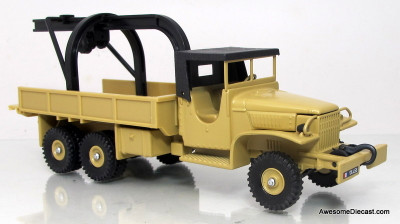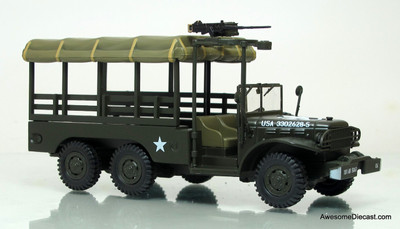Atlas
Atlas 1:43 GMC CCKW 353 6x6 Wrecker Truck: United States Army

Atlas 1:43 GMC CCKW 353 6x6 Wrecker Truck: United States Army
$57.42
The GMC CCKW, also known as "Jimmy", or the G-508 by its Ordnance Supply Catalog was a highly successful series of off-road capable, 21⁄2-ton, 6x6 trucks, built in large numbers to a standardized design (from 1941 to 1945) for the U.S. Army, that saw heavy service, predominantly as cargo trucks, in both World War II and the Korean War. The original "Deuce and a Half", it formed the backbone of the famed Red Ball Express that kept Allied armies supplied as they pushed eastward after the Normandy invasion.
The CCKW came in many variants, including open or closed cab, long wheelbase (LWB) CCKW-353 and short (SWB) CCKW-352, and over a score of specialized models, but the bulk were standard, general purpose, cargo models. A large minority were built with a front mounted winch, and one in four of the cabs had a machine-gun mounting ring above the co-driver's position.
Of the almost 2.4 million trucks that the U.S. Army bought between 1939 and December 1945, across all payload weight classes, some 812,000, or just over one third, were 2 1⁄2-ton trucks. GMC's total production of the CCKW and its variants, including the 21⁄2-ton, 6x6, amphibian DUKW, and the 6x4, 5-ton (on-road) CCW-353, amounted to some 572,500 units – almost a quarter of the total WW II U.S. truck production, and 70 percent of the total 2 1⁄2-ton trucks. GMC's total of ~550,000 purely 6x6 models, including the DUKW, formed the overwhelming majority of the ~675,000 six by six 2 1⁄2-ton trucks, and came in less than 100,000 shy of the almost 650,000 World War II jeeps. Additionally, GM built over 150,000 units of the CCKW's smaller brother, the 1 1⁄2-ton, 4x4 Chevrolet G506, at the same factory.
The GMC CCKW began to be phased out, once the M35 series trucks were first deployed in the 1950s, but remained in active U.S. service until the mid-1960s. Eventually, the M35 series, originally developed by REO Motors, succeeded the CCKW as the U.S. Army's standard 2 1⁄2-ton, 6x6 cargo truck.
Initially, all versions used a modified commercial closed cab design having a metal roof and doors. By 1944 an open cab version, with a canvas roof and doors, was used. This was easier to build, and the roof could be removed to lower the shipping height. 1 in 4 of cabs had a machine gun mounting ring above the co-driver's position.
The CCKW provided a platform for the widest range of bodies on any U.S. military vehicle, with the 12 ft (3.7 m) cargo version being the most common. As steel was more heavily rationed during the course of the war, the steel cargo bed was replaced by a wooden one. Wooden beds proved unsatisfactory and a 'composite' bed with steel sides, framing, and wooden bottom slats was developed. However, the composite bed was still unsatisfactory and the bed design returned to all steel. Standard cargo models had beds with fixed sides and a drop tailgate, as well as folding troop seats.
A standard rectangular van configuration was used in communications, medical, workshop, and many other specialty roles. Special built vans were also used.














